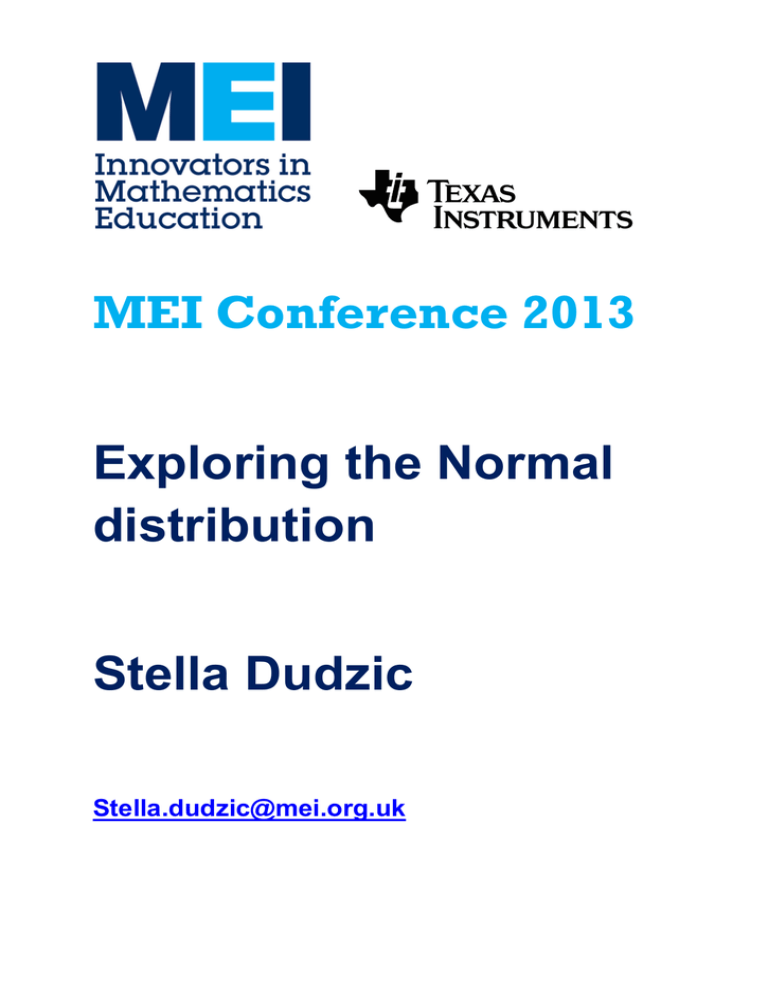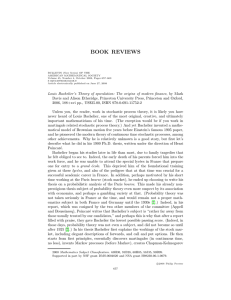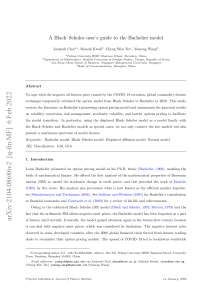MEI Conference Exploring the Normal distribution
advertisement

MEI Conference 2013 Exploring the Normal distribution Stella Dudzic Stella.dudzic@mei.org.uk Modelling the Market (Part 1) The graph below shows the daily closing price of Marks and Spencer shares over about a year. The problem Is there a way to model the changes in price of a share? Some theory Louis Bachelier • • • Comment on Bachelier’s thesis “The buyer believes in a probable rise, otherwise he would not buy, but if he buys, it is because someone sells to him, and this seller obviously believes in a probable decline. From this results that the market, considered as a whole, takes the mathematical expectation of all operations and of all combinations of operations to be zero.” Henri Poincaré A random walk • The idea of a random walk is a simple stochastic model. • A drunkard is equally likely to take a step forward or a step backward. • You can model a random walk by tossing a coin and moving forward for heads and back for tails. • The walk will look different if you repeat it BUT the probability of ending up at any point after a certain number of steps can be worked out. The father of financial mathematics PhD thesis 1900 “Théorie de la Spéculation” “L’ ésperance mathematique du spéculateur est nul” Deterministic and stochastic models • Deterministic – If the starting condition is known, the future can be predicted with accuracy • Stochastic – If the starting condition is known, possible futures can be assigned probabilities Some of Bachelier’s ideas in a nutshell • The previous history of stock market prices does not enable a prediction of whether they will go up or down next. • Price changes behave like a random walk (over continuous time). 1 Simulating a random walk You need a coin. Start at zero distance from start at move number zero. Toss the coin. Go forward one for heads and back one for tails. Record the random walk on the grid below. Now do another random walk on the second grid. 2 Probabilities for a 5 move random walk Distance from start +5 +4 +3 +2 +1 0 -1 -2 -3 -4 -5 Probability What does the probability distribution look like for longer random walks? 3 Samples from Normal distributions with variance 1.6 A 8.124 5.441 6.582 5.886 6.013 6.760 6.535 6.878 5.853 6.367 B 7.488 4.321 6.555 5.462 7.508 6.262 6.498 5.230 6.319 2.818 C 4.031 3.904 2.270 5.016 4.269 5.889 1.176 2.823 3.952 2.356 H 5.045 6.495 6.756 5.394 7.825 3.499 3.908 5.890 4.555 7.025 J 5.160 7.594 7.714 7.824 4.137 8.013 5.516 7.722 5.112 6.042 K 4.861 4.314 4.027 1.787 2.062 3.352 3.591 2.023 3.975 3.813 Q 3.203 6.481 2.318 6.585 2.777 4.532 2.645 4.561 4.945 4.850 R 8.225 7.049 5.767 6.060 6.003 4.417 9.948 5.547 6.833 7.898 D 3.339 7.510 7.567 4.996 7.171 6.760 7.411 4.662 6.773 5.284 E 6.230 5.106 4.969 5.736 7.760 8.284 9.300 5.780 8.295 7.149 F 8.220 6.470 9.048 9.464 6.347 6.226 5.158 3.177 5.265 5.964 G 3.833 5.121 2.415 5.296 4.202 4.670 4.218 2.379 1.510 3.693 L 5.507 6.993 6.320 5.920 6.723 7.065 8.666 6.274 7.052 8.682 M 5.812 8.261 8.650 5.090 6.941 7.132 6.172 5.955 7.030 6.286 N 2.858 5.088 2.144 3.196 3.135 5.986 4.845 5.134 4.387 3.349 P 7.292 6.293 6.271 7.790 5.918 7.934 3.943 4.062 7.680 7.447 © MEI 2008 31/07/2013 Normal Distribution 1 31/07/2013 UK babies • How much do you think a typical baby weighs at birth? • What proportion of babies do you think are born weighing less than 2.5 kg? Source: Office for National Statistics licensed under the Open Government Licence v.1.0. 2 31/07/2013 Mean weight • The graph on the previous slide is from the ONS Health Statistics Quarterly Autumn 2008. • The mean birth weight was reported as 3352 g with a 95% confidence interval of (3351, 3354). • Does this mean that 95% of babies had weights between 3351g and 3354 g? Below 2.5 kg • About 6% of babies were below 2.5 kg at birth. 3 31/07/2013 Two papers • Imagine two exam papers: – Paper A has mean score 73 and standard deviation 6 – Paper B has mean score 78 and standard deviation 15 • Which paper would have more students scoring over 90? • Which paper would have more students scoring less than 60? • Which paper would you rather do? Two papers 0.1 f(x) 0.08 Normal Distribution: N(73, 36) 0.06 0.04 Normal Distribution: N(78, 225) 0.02 20 40 60 80 100 120 1 4 Hypothesis testing template Step Notes Decide null hypothesis This is often that a population parameter = a particular value. Remember to say what any letters stand for. Decide alternative hypothesis Decide significance level The form of this can depend on what is being investigated Often 5%, but it need not be. You will be told what to use in exam questions. You will be able to tell from the form of the alternative hypothesis. Is it a one or twotail test? Write down key information Work out the sample mean. If the null hypothesis is true, write down the distribution the sample mean comes from. For a sample of size n from N( , 2 ) the sample mean, X , has a normal distribution with mean and variance 2 n . Calculate test statistic from the sample You will need to standardise so that you can use Normal tables. (Subtract the mean and divide by the standard deviation). Make a decision on the basis of the test statistic This can be done by using a critical region. State the decision in context







